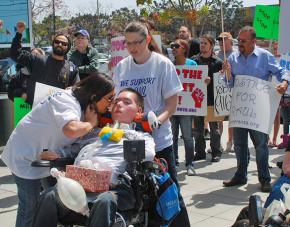Medi-Cal cuts threaten lives
reports on a protest of Occupy San Diego and disability rights activists who are fighting to stop Med-Cal cuts that could have disastrous consequences.
RAUL CARRANZA is in a fight for his life. At 22 years old, he is able to speak only slightly and move a couple fingers on one hand. He's permanently on a ventilator and requires 24-hour nursing care to maintain his airway.
But it's not muscular dystrophy that's threatening Raul's life--it's budget cuts.
Medi-Cal, the California state program that administers federal Medicaid dollars, provided the 24-hour nursing care Raul needs until his 21st birthday. Then, the bottom fell out.
"Medi-Cal cut my funding nearly in half," he explained to a crowd gathered outside the Chula Vista Medi-Cal office on April 6 to protest the cuts to the program. "This wasn't done because I got better or because I did something wrong, but for the simple fact that I turned 21. It's a policy of theirs that adult patients get less money than pediatric patients."
Raul went on to explain that since taking up the fight for his benefits full time, he has had recurring nightmares in which he cries out for his nurse, but his voice is gone, and no one comes to help him. This nightmare may become reality on April 16, when his private insurance runs beyond its yearly cap and his available nursing hours are reduced from 24 hours a day to the 11 hours a day Medi-Cal will pay for.

Raul's brother, Pablo Carranza, also spoke, and explained that he's approaching his 21st birthday--placing him in the same predicament as his brother, since he too requires 24-hour care. About the Medi-Cal administrators, Pablo has little to praise: "They hide behind the curtain so that they won't have to see the pain that they are responsible for."
SOME 80 people attended the rally and protest, several of whom are Medi-Cal or In-Home Supportive Services (IHSS) recipients. The event was organized with Raul by the Occupy San Diego Labor Solidarity Committee, a group made up largely of rank-and-file union members and labor activists.
Gregg Robinson, political vice president of the American Federation of Teachers, connected the plight of those facing benefit cuts to the larger failure of the system to care for those in need by drawing an analogy to the Titanic--a disaster in which two-thirds of the first class passengers survived, while three-quarters of the other passengers and the crew perished.
"Let's take a look at what's going on up there in first class," he suggested, explaining that the richest 85 people in California have assets totaling more than $200 billion, while the governor, Democrat Jerry Brown, is proposing $500 million in cuts to Medi-Cal, on top of the cuts already made.
Following a short but spirited march from the park adjacent to the building, led by the Medi-Cal and IHSS recipients, the group performed a mic-check at the entrance, reading a list of demands. After the ranking official dismissively announced that she would forward Raul's letter and scurried inside, Raul and his mother entered the building to demand a response from the director of the Department of Health Care Services (DHCS) and the governor.
Shortly thereafter, Michael Condon, a veteran who has been paralyzed from the neck down for over 40 years and who was wearing a "We Support Raul" shirt, was blocked by private security while trying to enter the building with his caregiver. For several minutes, other members of the public were let in while Condon was refused access, prompting the crowd to chant "Let him in!" and "No justice, no peace!"
When the security guards were unable to provide a reason why he was not allowed in, they finally granted Condon entry into the office. While he and Raul were inside, protesters proceeded to call every phone number connected with the office of the director of DHCS to demand a response.
In the end, Raul Carranza and Michael Condon exited the building after receiving confirmation that the list of demands was faxed to both the director of DHCS and the governor. Raul had wished to remain indefinitely at the office to force the issue, but the battery on his wheelchair was running low. After thanking the remaining protesters for supporting the cause, Raul vowed to continue the fight.
A friend of his, also a muscular dystrophy sufferer in a wheelchair, asked to speak. He said simply, "Justice for Raul is justice for all."


